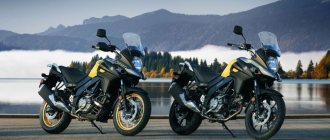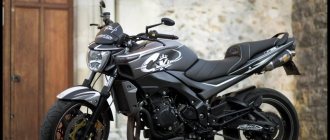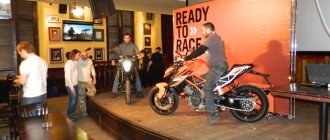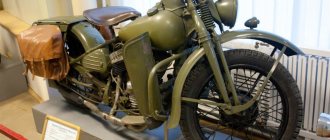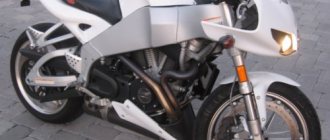Technical indicators
It is necessary to provide the characteristics of the 2008 suzuki gsx r 750, identifying the strengths and weaknesses:
| Dimensions (length; width; height) | 204; 71.5; 112.5 cm |
| Weight (dry) | 165 kg |
| Speed | 275 km/h maximum |
| Fuel tank volume | 17 l. |
| Engine | 4-stroke 4-cylinder liquid cooled |
| Engine capacity | 750 cc cm |
| Start | Electric starter |
| Engine power | 150 l. With. at 13200 rpm |
| Brake system | Disc hydraulic |
| Suspensions (front; rear) | Inverted telescopic fork; pendulum with monoshock absorber |
First of all, it is worth noting the excellent power of the 4-stroke engine, as well as the speed it develops - it was not for nothing that the motorcycle was used as a racing vehicle. The ergonomic shape of the model, low weight and dimensions provided Suzuki with good dynamic performance.
The appearance of the Suzuki GSXR 750 as a whole leaves a positive impression - everything in the motorcycle is thought out to the smallest detail, from the reliefs of the plastic lining to the shape of the front fairing.
A reliable hydraulic disc brake system, as well as a soft, adjustable suspension allowed the driver to feel comfortable and confident on various types of road surfaces.
MY MOTORCYCLE
The Suzuki GSX-R750 is one of the most significant sportbikes of all time, and this year the model celebrates its thirtieth anniversary on the American market. The Gixxer has gone from 600cc to 1000cc, but the 750cc version remains the most balanced in the market. In this article, the GSX-R750 will be assessed by Australian Motorcycle correspondent Jeff Ware, who restored the 1985 Gixxer discussed below. Ware compares the original GSX-R to its modern sibling, illustrating the evolution of the sportbike over the past three decades.
The GSX-R750 became a sensation in the motorcycle world when it was introduced at the 1984 Cologne Motorcycle Show in Germany. It had a full fairing, an aluminum frame, incredibly light weight and 100 hp.
Among almost all motorcycle enthusiasts over 35 years old, there are two types of statements: some say about the GSX-R750 “I wanted it so bad” or “I had it.” This model had the same influence as the 1992 Honda Fireblade and the 1998 Yamaha YZF-R1. No bike has ever looked so powerful and yet so light.
This bike looked faster, lighter and better than any motorcycle available at the time. It also beats out the competition with its affordable price. That same year, Yamaha released the FZ750 (700) and Kawasaki continued promoting the GPz900R. All of these bikes are great in their own way, but in terms of performance and weight, none of these models can beat the GSX-R750F. A resounding success.
The GSX-R project was led by Etsuo Yokushi, who rewrote sportbike history with the GSX-R750F. Yokushi-san was firmly convinced of the need to promote high technology in an era when designers had a rather conservative position. He loved racing and was the brains behind Hans Muth's Katana. These qualities gave him the impetus to create a super sports motorcycle.
How did Yokushi-san and his team manage to create such a great bike? To understand this, we must consider the situation in Japan at that time. Most four-stroke superbikes of the day were simply a souped-up version of the Universal Japanese Motorcycle. They were heavy and clumsy, but at the same time very reliable. We're used to Suzuki GS, KawasakiZeds, Honda CB900 and 1100, and of course the Yamaha XS11. These were large, heavy motorcycles with small brakes and low suspension, all packaged in steel frames and fitted with skinny tires.
On Yokushi-san's side, the GSX-R drew on the experience of the GS and GSX750R racers driven by Kiwi Graham Crosby and Lan Willing (brother of Warren Willing, who was a GP tuner).
While development of the GSX-R was underway, Suzuki released the RG250WE two-stroke and the GSX-R400 four-stroke. These models help the public and other manufacturers understand the three main trends that Suzuki will follow in the future.
Yokushi realized that if the GSX-R400 could be made 18% lighter, then the same steps could be applied to the GSX-R750. At the time, engineers had already agreed to a power limit of 100 hp, so Yokushi knew that reducing weight was the only way to improve performance.
The company's engineers set a goal of reducing weight by 20% compared to competitors of the 750, power of 100 hp. and a weight of 388 lbs.
The chassis was given the same attention as the engine. Yokushi insisted on using the same dimensions as racing bikes. “What works on the racetrack will work on the street. The motorcycle does not know where it is currently riding,” he said.
Since the introduction of the GSX-R750 in 1985, sportbikes have come full circle - light, heavy and light again. One thing is for sure: the performance of motorcycles in this class is divided into the era before and after the GSX-R750F. Even after 30 years, I rate the appearance of this bike very highly, I think it is one of the most beautiful motorcycles ever released. But my opinion may be biased, since I spent three years tinkering with this model, restoring such a bike.
I ride a motorcycle and I love it. I have nine motorcycles, some of them are modern, some are more “adult” models, but the GSX-R750F is the lightest of them. Compared to the new version, it weighs 2 pounds lighter.
Don't get me wrong - everyone has come a long way at 30 years old, the old Slabbie won't even come close to the new one on the track or on the street. But in terms of its era, this model blew up its niche. I was 10 years old, but I still remember this bike at the Suzuki dealership. I rode a BMX bike in the rain and hail and looked through the window at the motorcycle I dreamed of, and which I have 30 years later.
The fact that the new engine has the same bore and stroke of 70x48.7 mm proves that Suzuki engineers did everything right then. Despite the changes that were adopted in 1988 and 1989, these parameters returned in 1990 and have remained so ever since. With modern cylinder head technology and electronics, the ST engine is 50% more powerful.
Driving impressions of a 1985 GSX-R750
I spent three years restoring this bike, spending $9,000 and hundreds of hours in the garage. To say I was excited the first time I rode it would be an understatement.
I am very familiar with the modern 750 and have put many miles on this bike. I had this bike in 2011. I also saw Yamaha's 1985 FZ750, which was Suzuki's main competitor.
This bike has a great old school feel. The huge glass is three to four times larger than modern versions. The picture is completed by a tall and very narrow gas tank with a vent directly under my chest.
The handles are spaced far enough apart. It shows me sitting inside the motorcycle, not on the motorcycle. The seats are plush and very low. The aluminum folding running boards are terribly high and create a cramped feel. The panel is very cool and has an 80's feel. A subtle detail is that the tachometer only starts counting once 3,000 rpm is reached, which clearly speaks to Suzuki's intentions.
The first thing I heard when I turned the ignition key... nothing! There is no fuel pump noise, no servo motor adjustments, no epileptic seizures.
I turn the fuel cock and remove the throttle (when was the last time you did something like that?) and press the starter button. The bike coughed and sputtered several times, the smell of unburnt fuel clinging to my skin.
It seems to me that the warm-up lasted forever; at idle it lasted about five minutes. After heavy throttle, the motorcycle instantly reminded me of its class and quickly moved into battle. I will never forget this moment, this incredible feeling. A few laps before I get low on fuel, I ride the bike as fast as I can, that's the real test!
The engine runs smoothly and confidently, the Suzuki gearbox is simply silky and can put many modern “colleagues” to shame, the lever travel is minimal and it is tuned perfectly. I can completely understand why these bikes were so popular back in the day.
Maximum torque can be obtained at 8,000 rpm, and the bike is tractable in both the old and modern versions.
The old model has a top speed of 55 mph in first gear, 72 in second, 95 in third, 115 in fourth, and the 2015 model does 132 mph in the same spot.
I must admit that my 1985 example was equipped with an upgraded suspension and upgraded brake pads and rotors. But they still struggle to match the braking system on the new model.
Turning is done old school style, with a lot of braking before the turn. The skinny Pirelli Sport Demons tires provide sensational cornering speed and make the steering feel lighter than I expected for 18-inch wheels.
Overall, the old bike is a stunning bike, but needs to be ridden with grace and patience, but the new model can deliver all the racing qualities.
Ride impressions of the 2015 GSX-R750
This bike looks great and can be called a true successor to the glory of the GSX-R750. I definitely like the new body and muffler.
First I walked around the motorcycle and appreciated its appearance. So what we have: minimal bodywork, a tiny screen, incredibly compact size compared to the 1985 model, and a huge, meaty frame. The new version appeared in 2011 and remained unchanged, the changes were only cosmetic.
Of course, I didn’t experience the same delight as with the 1985 version; after all, childhood memories are associated with it. When sitting on the bike, the tank feels more comfortable, but there is a general feeling that the bike is very low due to the flat surfaces of the tank and seat, as well as its narrow rails.
Like all GSX-R750s, the bike has high pegs that are uncomfortable for me. Even at their lowest level they are too high. I sit much closer to the handles on this than on the old version.
It seems that there is more space between the knees, but they are much lower. The seat is higher and it itself is firmer and wider, the position is generally more aggressive, although 30 years ago people said that it could not be more aggressive.
The ignition on the new bike is much faster, there is no choke (no carburetor), no need to warm up for several minutes. The operating sound is traditional for motorcycles of this class.
On the track the bike picks up speed much faster. I even smiled while accelerating uphill at twice the original engine's speed. The suspension and braking system from Brembo are simply unique, the ride is comfortable and easy.
After I warmed up the tires, I put my head down and began my normal testing regimen - one familiarization session, one run-up session, just one session to break the lap record. Acceleration is very fast and the bike feels great while braking at 220 km/h. The bike handles perfectly in corners, it seems that it can be turned in all directions, and it will obediently carry out any task. It was more difficult with the old version; it is more comfortable on straight roads.
Suzuki engineers have done a very good job on the geometry - even under hard braking the bike performs perfectly, it reacts quickly and keeps the front wheel on the track in all conditions.
I was very impressed with the GSX-R750, but I love my old 1985 model.
GSX-R750 1985 GSX-R750 2015
Claimed power: 75 kW (100 hp) at 110.3 kW (146 hp) at 10,500 rpm 13,200 rpm per minute
Claimed torque: 68 Nm (52 lb-ft) 86.3 Nm (63.6 lb-ft) at 8,000 rpm at 11,200 rpm per minute
Dry weight: 176 kg (388 lb) - 190 kg (419 lb)
Fuel tank capacity: 18.5 L (4.9 gal) - 17 L (4.5 gal).
Engine: In-line four-cylinder, four-cylinder, four-stroke, four-stroke, oil-cooled, liquid-cooled, DOHC DOHC
Bore x stroke: 70.0 x 48.7mm 70 x 48.7mm
Volume: 749 cubic centimeters - 749 cubic centimeters
Compression ratio 9.8: 1 12.5: 1
Fuel Delivery: VM29SS, TTV 8-injector EFI with SDMS, and ignition transistor new ECM and transistor ICU
Transmission: Six-speed Six-speed cassette type
Clutch: Wet, multi-plate, Wet, multi-plate hydraulic control
Final drive 530 Chain O-ring 530 Chain O-ring
Wheelbase 1425 mm (56.1 in) 1390 mm (54.7 in)
Fork 26º 23.45º
Tail 107 mm (4.2 in) 97 mm (3.8 in)
Front Brake: Dual 300mm Dual 310mm stainless steel four piston rotary calipers, floating stainless steel rotors, Brembo four piston 32mm radial mount calipers, Nissin 17.46mm master cylinder
Rear Brake: 220mm 220mm stainless steel caliper, stainless rotary, two piston steel rotary, Nissin single piston 30.23mm caliper, Nissin 14mm master cylinder
Wheels: Cast Aluminum, Cast Aluminum, 18" 17"
Tires: 110/80-18 front, 120/70-17 front, 140/70-18 rear 180/55-17 rear
Ground clearance: 140 mm (5.5 in) - 130 mm (5.1 in)
Seat height: 755 mm (29.7 in) - 810 mm (31.9 in)
Overall height: 1200 mm (47.2 inches) - 1135 mm (44.7 inches)
Overall length: 2130 mm (83.9 in) - 2030 mm (79.9 in)
1985 GSX-R750 technology
While competitors turned their attention to liquid-cooled engines, Etsuo Yokoushi led the other camp. He wanted a lightweight and minimally complicated design. The engine for this model was developed taking into account the racing experience of the GSX750E.
The internal combustion engine has four cylinders and the same number of strokes, the diameter x stroke ratio is 70.0x48.7 mm, compression is 9.8x1. Liquid cooling was eliminated and the same technique was used as on the XN85 Turbo, resulting in oil jet cooling. More oil than usual also circulates in special channels around the engine. This engine has a power of 100 hp. without any danger of overheating.
Every part of the GSX750E engine has been redesigned. The pistons are 10% lighter, the connecting rods are 25% lighter, the crankshaft is 20% lighter, the cylinder head is 22% lighter, the cylinder block is 17% lighter, and the gearbox and clutch have also been redesigned to make them lighter.
source vk.com/mskmoto
Advantages and disadvantages of suzuki gsx 750
The advantages of the model include:
- Engine power;
- Build quality proven over the years;
- Stylish design;
- Impressive dynamics;
- Small weight compared to other motorcycles in this class;
- Relevance;
- Comfortable fit;
- Availability of parts.
Among the disadvantages, it is worth noting the need to adjust the suspension, a weak rear brake, as well as expensive repairs. Some novice drivers, having switched to the GSX 750, experience difficulties when cornering, but over time the problem is solved.
Still, it’s good to know what you want. I've heard that difficulty making choices is a sign of impending schizophrenia. This doesn’t seem to be a threat to me, although my preferences make it difficult to communicate with overly serious, long-armed owners of choppers or owners of narrow-headed plastic lighters hunched over in racing overalls. ] Theoretical reflections, leafing through the pages of local auto-moto ads and periodic fitting of motorcycles in showrooms continued from the winter until the purchase. In winter, I began my search with Hornet.
600 cc, round headlight, everything is as it should be, I liked it. It should be noted here that since I am not a biker, the fetish component means a lot to me. Not narcissistic, realized in the protected shoulders of a courageous racing outfit, but iron. The motorcycle, that is, must be beautiful. For me at least, for the rest... it doesn’t matter. But a neighbor (the owner of a 650 cc bandit) dissuaded him from the Hornet - “you’ll quickly get to six hundred, look for more.” Besides, since I don’t live in the city, I would like something more or less comfortable. Hornet, in my opinion, is a city spendthrift. Narrow and nervous. But this is the opinion of a noob, Mamonov would say - “I’ve read a lot of books on the Internet.” In general, you can’t take it seriously. I found “more.” X-11.
But I’m being rash, it takes practice to burn such a rocket, it’s not enough yet. More precisely, not at all. And the consumption, thank you, my car eats less. I tried on the X-11 and it felt like I was sitting on a small intercontinental rocket. With a one way ticket. For this purpose, I went to the neighboring region, and at the same time I was once again convinced that in the photo one can show a spendthrift not at all as wretched as it really is. In short, taking into account the allocated money and preferences, there were two options left - Khizher 1200 and Inazuma 750. I looked at Inazuma for a long time and almost every day on the advertisement site. Color, lines, performance characteristics - everything was excellent. And yes, in the photos they both sparkled and beckoned, but in reality everything turned out to be a little different. A friend came, by the way, the owner of a GTS, he, of course, was promoting Yamaha, and we went with him to look, and, if we liked it, to buy and drive it, since I don’t have a category, and it’s 170 kilometers from the purchase to the house. We looked.
Once there, the hijer turned out to be quite road-weary, despite the relatively new year of manufacture. And the owner turned out to be a decent guy, about 50 years old, and said that he would sell it, of course, if I want, but he strongly advises against taking it as a first spendthrift. From the saddle he seemed a little big to me. Khizher, not the owner. And I’m not ready to own such a motorcycle yet (plus the tank is painted, the cooling fins are broken, the tail has been welded). I can, of course, I’m always excellent with technology, but I think it’s too early, and so we went to see Inazuma. That one, as it turned out, looked exactly the way a 1999 motorcycle should look. Plus, there are notes in the owner’s book about when things changed. And this color is just a song. Everything was clear in place. An hour for a notary, two sets of keys and home, 170 km, the moth is ahead, I follow in the car. We arrived without incident, gurgling a full tank of 95 before leaving. Having poked around the calculator upon arrival, I found out that the approximate consumption was 5.3-5.4 liters. Not bad. And while driving, the driver found out that Inazuma’s saddle was uncomfortable, contrary to online reviews from owners. Like this. But more on that in the next episode.
«>


